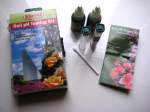Home › Container gardening
Gardening In Containers
An Easy Way To Spruce Up Your Garden!
Gardening in containers is a great way to spruce up your garden. Whether you choose a simple window box or a more lavish grouped display, containers will brighten up dark corners and introduce a splash of colour and fragrance - you can even grow vegetables in them!
In outdoor spaces with no soil such as courtyards, patios, balconies and terraces, gardening in containers is absolutely essential as it is the only realistic way to introduce planting.
But whatever type of garden you have, gardening in containers allows you to move your plants around and group them together in different ways to give your garden or patio an instant facelift.
What's more, you can even take your container garden with you when you move!
Check out the container gardening tips below and follow the links to help you create your own, fabulous container display...
What You Can Grow
There is virtually no limit to the types of plants you can grow: trees and shrubs; perennials; bamboos, grasses, ferns and spiky plants; flowering bulbs; colourful annuals; climbers; trailing plants ... the list goes on and on! The only limit is your imagination.
Gardening in containers also solves that tricky problem of growing plants that are not suited to your garden soil type. For example, if you have chalky soil but love camellias, plant them in large pots of ericaceous compost.
It is also the solution to growing plants that need winter protection - grow them outside in the spring and summer and simply bring them indoors in autumn.
Pots and Planters
Pots and planters can be decorative features in their own right so choose them to suit the style you are aiming for. I've put together some tips on how to select the best types of pots and containers for your needs (and your pocket!) and suggested some low budget solutions.
For the best effect use a variety of pot and plant sizes to create atmosphere and visual interest.
Design Tips
Before you begin to design your container garden make an assessment of the available light levels in your garden and choose plants accordingly.
- To add texture and visual interest to your display, try grouping plants with contrasting foliage.
- Include some evergreens with a sculptural form - Tree Ivies (x Fatshedera lizei), Japanese Aralias (Fatsia japonica), and Cabbage Palms (Cordyline australis) are all good for this purpose.
- Place aromatic and scented plants near benches or other seating areas.
- Use a limited palette of foliage and flower colours to create atmosphere.
- If you use your garden in the evening, plant white or light coloured plants as these become almost luminescent as daylight fades. Night scented stocks (Matthiola bicornis) and tobacco plants (Nicotiana) also release their heady perfume at this time.
Adding Vertical Interest
When designing your container garden try not to keep everything at ground level but introduce vertical interest by:
- ... including containers at different heights to increase visual appeal. You can either buy purpose made stands or simply use bricks, concrete blocks or even empty upturned pots to raise them off the ground.
- ... using hanging baskets on walls and fences. Both hanging baskets and window boxes allow you to 'dress up' the outside of your house.
- ... planting climbers, trees, shrubs and large foliage plants.
Tackling Small Spaces
Small spaces can be tricky. Avoid the temptation to use lots of tiny containers filled with small plants as these end up looking fussy and unsatisfactory. Instead:
- Use large plants, such as trees, shrubs and large-leaved foliage plants to make a bold statement. This always looks more effective. Just make sure the containers you use are large and sturdy enough not to topple over!
- Go for a simple planting scheme using a small range of plants.
- Increase the sense of light in small enclosed urban spaces by using trees with delicate leaves. Japanese Maples are particularly good for this and grow well in containers.
Home › Container gardening
